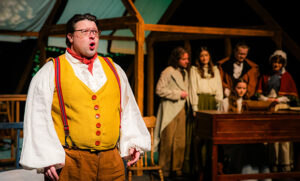I grew up watching Canadian television. For me, as a child in Halifax, Nova Scotia, I was not making a political statement, nor was I choosing to be patriotic, nor did I know that I was, in my own tiny way, helping to foster and support the careers of hundreds of artists who were enjoying a lucrative acting career working in our country. No, I was just watching the shows that I liked.
When I was very young, I strongly preferred Mr. Dressup (Ernie Coombs) to Mr. Rogers (Fred Rogers). It was not because Coombs was Canadian (at least after 1994) and Rogers was American (I had no idea), but because I responded far more ardently to Mr. Dressup’s creativity; his singing and dancing, his theatrical stories, his amazing drawings and of course Casey and Finnegan, as opposed to, what seemed to me to be, Mr. Rogers’ more stoic house of cardigans.
I have vivid memories of Sunday night bath time as a child because I remember having to insure that, as much as I loved playing in the water, I was in and out of the tub before 7:00pm because that was when Road to Avonlea came on, and it would be a temper tantrum travesty in our house if I by chance missed even a moment of Road to Avonlea. All the girls at my school watched this show religiously. How we wanted to be Sara Stanley (Sarah Polley) and to have her charming old fashioned adventures. We idolized Felicity King (Gema Zamprogna), despite the fact that she was kind of snobby, because she was older than we were and had such beautiful grace about her. Lally Cadeau and Cedric Smith became our beloved TV parents of Sunday night whose authority we respected with the sort of solemnity that only grows in the heart of a child. And, even at six or seven years old, I knew that Jackie Burroughs’ magnificent performance as Hetty King would be something I would remember and cherish for the rest of my life.
Of course I knew that Road to Avonlea was set in Canada; my grandparents were born on Prince Edward Island and I loved Anne of Green Gables and Lucy Maud Montgomery and of course I felt a connection to her because I knew that my great grandparents had lived on a farm quite similar, and that my own family had grown up very much alongside the mythical town of Avonlea. But as a child I had no idea that it mattered where a television show was made, and I had no idea that the fact that this one was filmed mostly in Ontario, with actors who were Canadian, was any different than Dr. Quinn Medicine Woman, which I also liked, or Who’s The Boss and Growing Pains which I also watched every week. The point is, though, that I could not tell the difference. To me, Road to Avonlea was just as wonderful, just as sophisticated and filled with talent as any other show on television.
As slightly older elementary school students my friends and I discovered Degrassi Jr. High and we quickly found ourselves immersed in pure teenaged drama, while also being confronted with (and educated about) issues of racism, sexism, drugs, alcohol, smoking, sex, homophobia and AIDS. At eight and nine years old I watched Degrassi to be cool, but I remained unaware of the strong impact the show had on shaping the decisions I would make later in life and the sorts of people I would choose as role models as I grew older. Only Full House made a larger impression on me in the late 1980s and the early 1990s, but I held Degrassi’s Caitlin Ryan (Stacie Mistysyn) in every bit as much esteem as Full House’s DJ Tanner (Candace Cameron). Unable to put it into words at the time, I realize now that as a child my goal was to grow up to be as smart, beautiful and full of light and integrity as they were. In hindsight, as maudlin and cheesy as it may seem, I am so grateful that I grew up at a time when there were such wholesome, yet strong and clever female protagonists on television; characters who were continually challenged (ethically, intellectually and physically) in the same way that young girls are challenged in schools all over the world. Of course my friends and I each had crushes on Degrassi’s Joey Jeremiah (Pat Mastroianni) with his boyish charm and penchant for mischief and fedoras, and we adored Spike (Amanda Stepto), who seemed the ultimate in cool with her amazing hair and her devotion to baby Emma. When Degrassi Jr. High was rebroadcast in syndication in 2000, my entire tenth grade class watched all the episodes again, relishing in its hilarity, its humanity, and all of its brilliance and terrible fashion choices. We watched it alongside Dawson’s Creek and Buffy the Vampire Slayer and didn’t think twice about it.
I never thought about Canadian television or the “quality” of Canadian television until Canadian television as I knew it was practically extinct. While I was watching Mr. Dressup, Babar, The Big Comfy Couch, The Raccoons, Sharon, Lois and Bram, Road to Avonlea, Degrassi Jr. High and You Can’t Do That On Television it never crossed my mind that these shows should be considered “inferior” because they came from my country and not the home of Hollywood. It would have seemed absurd if someone had said that to me at six years old and it seems just as absurd to me now.
In short; I don’t buy the argument that I hear from the Broadcasting Companies, from the Cable companies, from our government and from every apathetic Canadian citizen who is content to simply absorb what is being fed to him. I don’t believe that Canada is incapable of creating television programming that is just as proficient, just as intellectual, artful, funny, sophisticated and socially relevant as that which is concocted in LA. What is more, I KNOW it isn’t true. Therefore, why should I stand by and watch as the Canadian Radio-television and Telecommunications Commission, the local and national Canadian broadcasters and the Canadian cable companies sidestep and blatantly ignore the issue that Canadian citizens deserve to have more Canadian content on their televisions, in their communities, in their homes and in their lives.
The truth is that when the CRTC, the Broadcasting Companies, our government and other citizens of Canada choose to pay a small proportion of the cost of American television programs, rely on Hollywood to popularize the shows and reap the rewards from advertisers, they are sending Canadians a message that our art, our culture, our artists, and our voice just DOESN’T MATTER. The fact that we as a country are not outraged by this infuriates me. We are Canadians, and our stories and our unique perspective on the world is essential to this country, and it is about time that we all stood up and asserted the fact that we are proud of who we are, and we are proud of the talented people who live here, the artists, the humanitarians, the athletes, and the local heroes who are championed by local News Stations. The immediate issue may be whether or not we are willing to pay a TV tax for local programming, but the long-term issue needs to be how absurd the immediate issue is. Why are we paying to see Charlottetown while we get New York for free?
Imagine if tomorrow we woke up and all the American broadcasting stations had been taken over by Tokyo. Imagine if the American people were given the option: they could adopt Japanese television as their own, or pay a special fee if they wanted to watch shows created in their own country. How do you think such a situation would be accepted in the Land of the Free? When will Canadians stop tolerating the quiet subjugation of its culture? I say enough is enough. It is time that we DEMAND that the CRTC find a resolution to the “Canadian Content on Television” debate that includes fostering and supporting Canadian television. Someone invested in Road to Avonlea, and Mr. Dressup and Degrassi Jr High. Someone allowed these shows to succeed and to thrive and to take on a life beyond Canada. It is that investment, that belief and faith in Canadian artists that makes all the difference between creating work that is world-class and that which feeds into the under-funded, under-developed, Canadian television stereotype. We have what it takes to compete and thrive in the creation of televised programming, one that can stimulate our economy and provide much needed jobs for thousands of Canadian citizens. We cannot allow this potential to be snuffed out by some lazy broadcasting tycoons who are content to continue to leech off America’s success.
After all, beavers do not leech; they work together, they create, and before long, they build something intricate, sturdy and beautiful that benefits them all. So should we.
When I was very young, I strongly preferred Mr. Dressup (Ernie Coombs) to Mr. Rogers (Fred Rogers). It was not because Coombs was Canadian (at least after 1994) and Rogers was American (I had no idea), but because I responded far more ardently to Mr. Dressup’s creativity; his singing and dancing, his theatrical stories, his amazing drawings and of course Casey and Finnegan, as opposed to, what seemed to me to be, Mr. Rogers’ more stoic house of cardigans.
I have vivid memories of Sunday night bath time as a child because I remember having to insure that, as much as I loved playing in the water, I was in and out of the tub before 7:00pm because that was when Road to Avonlea came on, and it would be a temper tantrum travesty in our house if I by chance missed even a moment of Road to Avonlea. All the girls at my school watched this show religiously. How we wanted to be Sara Stanley (Sarah Polley) and to have her charming old fashioned adventures. We idolized Felicity King (Gema Zamprogna), despite the fact that she was kind of snobby, because she was older than we were and had such beautiful grace about her. Lally Cadeau and Cedric Smith became our beloved TV parents of Sunday night whose authority we respected with the sort of solemnity that only grows in the heart of a child. And, even at six or seven years old, I knew that Jackie Burroughs’ magnificent performance as Hetty King would be something I would remember and cherish for the rest of my life.
Of course I knew that Road to Avonlea was set in Canada; my grandparents were born on Prince Edward Island and I loved Anne of Green Gables and Lucy Maud Montgomery and of course I felt a connection to her because I knew that my great grandparents had lived on a farm quite similar, and that my own family had grown up very much alongside the mythical town of Avonlea. But as a child I had no idea that it mattered where a television show was made, and I had no idea that the fact that this one was filmed mostly in Ontario, with actors who were Canadian, was any different than Dr. Quinn Medicine Woman, which I also liked, or Who’s The Boss and Growing Pains which I also watched every week. The point is, though, that I could not tell the difference. To me, Road to Avonlea was just as wonderful, just as sophisticated and filled with talent as any other show on television.
As slightly older elementary school students my friends and I discovered Degrassi Jr. High and we quickly found ourselves immersed in pure teenaged drama, while also being confronted with (and educated about) issues of racism, sexism, drugs, alcohol, smoking, sex, homophobia and AIDS. At eight and nine years old I watched Degrassi to be cool, but I remained unaware of the strong impact the show had on shaping the decisions I would make later in life and the sorts of people I would choose as role models as I grew older. Only Full House made a larger impression on me in the late 1980s and the early 1990s, but I held Degrassi’s Caitlin Ryan (Stacie Mistysyn) in every bit as much esteem as Full House’s DJ Tanner (Candace Cameron). Unable to put it into words at the time, I realize now that as a child my goal was to grow up to be as smart, beautiful and full of light and integrity as they were. In hindsight, as maudlin and cheesy as it may seem, I am so grateful that I grew up at a time when there were such wholesome, yet strong and clever female protagonists on television; characters who were continually challenged (ethically, intellectually and physically) in the same way that young girls are challenged in schools all over the world. Of course my friends and I each had crushes on Degrassi’s Joey Jeremiah (Pat Mastroianni) with his boyish charm and penchant for mischief and fedoras, and we adored Spike (Amanda Stepto), who seemed the ultimate in cool with her amazing hair and her devotion to baby Emma. When Degrassi Jr. High was rebroadcast in syndication in 2000, my entire tenth grade class watched all the episodes again, relishing in its hilarity, its humanity, and all of its brilliance and terrible fashion choices. We watched it alongside Dawson’s Creek and Buffy the Vampire Slayer and didn’t think twice about it.
I never thought about Canadian television or the “quality” of Canadian television until Canadian television as I knew it was practically extinct. While I was watching Mr. Dressup, Babar, The Big Comfy Couch, The Raccoons, Sharon, Lois and Bram, Road to Avonlea, Degrassi Jr. High and You Can’t Do That On Television it never crossed my mind that these shows should be considered “inferior” because they came from my country and not the home of Hollywood. It would have seemed absurd if someone had said that to me at six years old and it seems just as absurd to me now.
In short; I don’t buy the argument that I hear from the Broadcasting Companies, from the Cable companies, from our government and from every apathetic Canadian citizen who is content to simply absorb what is being fed to him. I don’t believe that Canada is incapable of creating television programming that is just as proficient, just as intellectual, artful, funny, sophisticated and socially relevant as that which is concocted in LA. What is more, I KNOW it isn’t true. Therefore, why should I stand by and watch as the Canadian Radio-television and Telecommunications Commission, the local and national Canadian broadcasters and the Canadian cable companies sidestep and blatantly ignore the issue that Canadian citizens deserve to have more Canadian content on their televisions, in their communities, in their homes and in their lives.
The truth is that when the CRTC, the Broadcasting Companies, our government and other citizens of Canada choose to pay a small proportion of the cost of American television programs, rely on Hollywood to popularize the shows and reap the rewards from advertisers, they are sending Canadians a message that our art, our culture, our artists, and our voice just DOESN’T MATTER. The fact that we as a country are not outraged by this infuriates me. We are Canadians, and our stories and our unique perspective on the world is essential to this country, and it is about time that we all stood up and asserted the fact that we are proud of who we are, and we are proud of the talented people who live here, the artists, the humanitarians, the athletes, and the local heroes who are championed by local News Stations. The immediate issue may be whether or not we are willing to pay a TV tax for local programming, but the long-term issue needs to be how absurd the immediate issue is. Why are we paying to see Charlottetown while we get New York for free?
Imagine if tomorrow we woke up and all the American broadcasting stations had been taken over by Tokyo. Imagine if the American people were given the option: they could adopt Japanese television as their own, or pay a special fee if they wanted to watch shows created in their own country. How do you think such a situation would be accepted in the Land of the Free? When will Canadians stop tolerating the quiet subjugation of its culture? I say enough is enough. It is time that we DEMAND that the CRTC find a resolution to the “Canadian Content on Television” debate that includes fostering and supporting Canadian television. Someone invested in Road to Avonlea, and Mr. Dressup and Degrassi Jr High. Someone allowed these shows to succeed and to thrive and to take on a life beyond Canada. It is that investment, that belief and faith in Canadian artists that makes all the difference between creating work that is world-class and that which feeds into the under-funded, under-developed, Canadian television stereotype. We have what it takes to compete and thrive in the creation of televised programming, one that can stimulate our economy and provide much needed jobs for thousands of Canadian citizens. We cannot allow this potential to be snuffed out by some lazy broadcasting tycoons who are content to continue to leech off America’s success.
After all, beavers do not leech; they work together, they create, and before long, they build something intricate, sturdy and beautiful that benefits them all. So should we.









